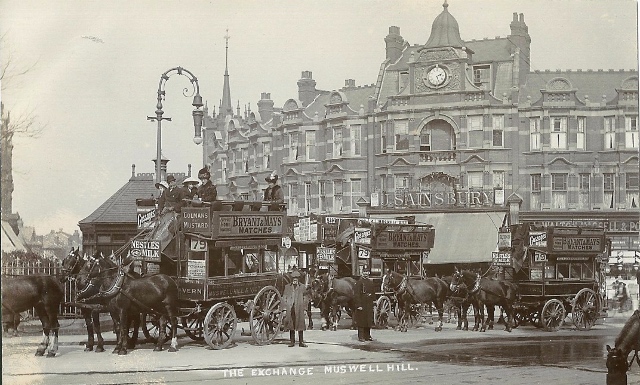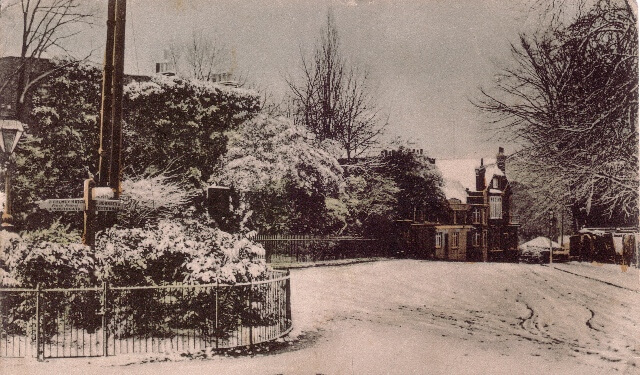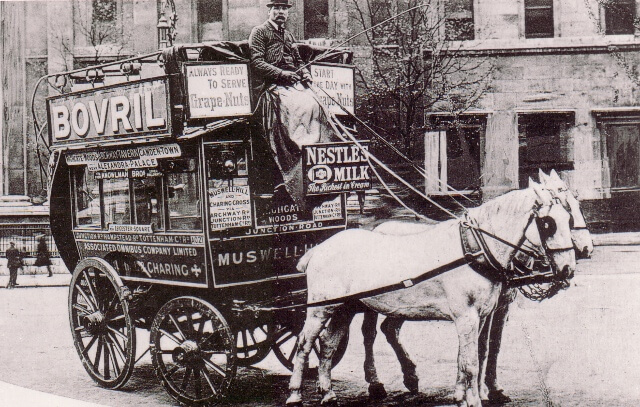A Politician’s Promise in November 1919 which came to nothing – plus ca change!
Reading the Hornsey Journal extract from November 1919 may give you a feeling of déjà vu. Not only was the fervent promise to get a tube to Muswell Hill within three years not kept, an underground line to this north London suburb never materialised. Why did William Kennedy Jones, Conservative and Unionist MP for Hornsey at the time, make such an extravagant promise to his constituents? What were the issues?

What types of transport existed already?
For much of the 19th century life for the few residents of Muswell Hill was conducted at a sedate pace. The owners of the large houses in extensive grounds either rode on horseback to their place of business in the City or were conveyed there by horse-drawn carriage.

Muswell Hill’s air of exclusivity was to disappear rapidly at the end of the 19th century when, within a year or two, the large properties were sold to James Edmondson and W J Collins, large-scale builders with ambitious plans to turn Muswell Hill into a respectable residential suburb. Gentlemen of property moved out and the middle classes moved in.
The development of Muswell Hill was rapid. Between 1897 and the start of the First World War (1914) the estates, together with their trees, gardens and orchards, were destroyed and avenues of large terraced houses took their place. The new occupants were professional men and City clerks who needed fast transportation to work. They could afford the daily bus and/or train fare to their offices. Initiatives in transportation became essential.
What fast means of transport did Muswell Hill ‘commuters’ have?
- 1873: the Finsbury Park to Alexandra Palace branch line, owned by Edgware, Highgate & London Railway, which linked to Moorgate, Kings Cross and Broad Street. This was essential for the new ‘commuters’ as central London could be reached in twenty minutes.
- 1901: the route between Charing Cross and Muswell Hill was serviced five times a day by twelve horse buses, each drawn by three horses. Their stand, in the middle of the roundabout at the top of Muswell Hill, was to be used for public transport vehicles thereafter.
- 1902: Cranley Gardens railway station on Muswell Hill Road opened as part of the branch line. Advertisements for houses in the area stressed the convenience of their location to the railway station.
- 1905: An electric tramway went from Turnpike Lane, Wood Green, to the foot of Muswell Hill, and then a single-deck tramcar took passengers to the west end of the Palace. The following year another tramway connected the east end of the Palace with Wood Green via Station Road. Muswell Hill was never to have a tram service as the hill was too steep.
- 1912: by the end of that year the number of licensed petrol buses in London equalled the number of licensed horse buses. However, large numbers of horses continued to be used for commercial purposes.
Why was there a traffic problem by 1919?
Central London was a jungle of traffic with no central authority to control it. All types of vehicles jostled for space; horse omnibuses, new petrol omnibuses, commercial vehicles, bicycles, an increasing number of private petrol engine cars and the electric trams. By 1914 London had the most extensive tram network in Europe.
In 1900 nearly a quarter of a million horses pulled road vehicles of every kind on London’s streets. In 1894 there had been a horse manure crisis! Another sort of crisis was drawn to the attention of the Government in March 1919, the great number of over-loaded, over-aged and under-fed horses working on London streets.

Some vehicles, especially those drawn by horses, had no brakes. There was no means of traffic control on the roads. The three-colour traffic light only started operating in London from 1925. Pedestrians took their lives in their hands crossing the road. Controlled crossings came much later – 1934 zebra crossings with Belisha beacons; 1962 panda crossings, replaced by pelican crossings in 1969.
It’s important to recognise that the underground system, which began with the opening of the Metropolitan Line in 1863, developed throughout the 19th century, with the Northern Line reaching Highgate Archway by 1907. An extension of the tube to Muswell Hill, however, would be very difficult given the terrain and would involve digging very deep underground through urban areas.
Why did Kennedy Jones think he could get a tube line to Muswell Hill?
A Ministry of Transport was set up in 1919 to sort out the by now overwhelming traffic problems. The London Traffic Advisory Committee was established in November 1919 under the chairmanship of none other than Mr. Kennedy Jones MP for Hornsey, a canny Glaswegian who had made his money in newspapers.
The Committee’s task was to co-ordinate and improve London traffic mainly through existing powers and to consider and recommend a permanent controlling authority. A week after Mr Jones’s assertion that he would get a tube for Muswell Hill within three years the Hornsey Journal commented, ‘Had he not been the chairman of the Advisory Committee on London traffic the assertion might have sounded rather egotistical, but from one in that capacity it simply came with authority’. Kennedy Jones estimated that a complete solution to the traffic problem, recouping some £20,000,000 in lost revenue, could be found in a few months.
Technical committees were established to find ways of regulating traffic, providing street facilities and planning future development. These met until Kennedy Jones’s committee reported in March 1920, but the competing interests of the many transport companies involved, a dire shortage of money to pour into the project and the relentless advance of the petrol engine vehicle defeated the voice of ‘authority’. Kennedy Jones died of pneumonia on the 20th October 1921.
The last line of the Hornsey Journal comment quoted above sounds a prophetic note, ‘But the world supply of petrol is not inexhaustible and we may wonder what will be done when the last tin has been used’.
Image credits
Hornsey Historical Society